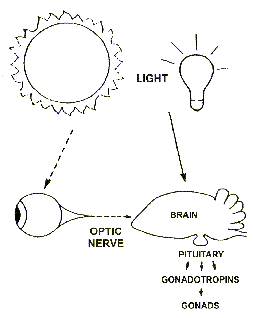



Importance of Proper Blackout Housing
By Michael J. Wineland, Extension Poultry Specialist, North Carolina State University |
| Figure 1 |
 |
| Figure 2 |
The major environmental cue for control of reproduction is day length. Reception of light for reproductive purposes by the pullet is not primarily through the eyes but rather by the light energy penetrating the skull, skin and feathers and then perceived by an organ within the brain (Figure1). The longer wavelengths (red) of visible light are more capable of reaching the brain than shorter wavelengths. Thus, the wavelength of light is an important factor when low light intensities are utilized in artificial light systems where the minimal light threshold of the bird may not be attained.
The bird has been shown to interpret daylength by the occurrence or lack of occurrence of light during a "photosensitive period" which occurs 11-16 hours after dawn in a 24 hour day. If after a "dawn" or lights on, the hen perceives light during the photosensitive period, she will interpret a long day. If no light is perceived during this photosensitive period, then the pullet interprets the day as a short day similar to a winter time daylength (Figure 2).
Perception of daylength in the pullet house will be the same if either natural or artificial light is utilized as long as the intensity of light is adequate to create sufficient contrast between the light and dark part of the day. The light part of the day must be greater than the minimum threshold level of light intensity for the pullet. The exact minimum threshold level is unknown, but we would suggest a minimum of 2 to 5 footcandles of incandescent light.
Complicating all of the above is the fact that pullets within a house are not identical in their response to light. This becomes evident with the variation seen performing uniformity checks during pullet weighing. The variation is simply part of the biology of living things. Thus, it is probably safe to say that all birds will not respond to exactly the same threshold level of light. It is important that sufficient minimal light intensity be provided such that all birds perceive the minimal threshold of light.
The use of blackout pullet houses is a common industry practice. The purpose of blackout housing is to sensitize (to make more responsive) the pullet's brain such that when the pullet is exposed to long daylengths in the breeder house, she will respond with efficient egg production. If the pullet is not exposed to the short daylengths prior to initiation of egg production, she will become refractory (become less responsive to the exposure of long daylengths) to light and will not properly respond to the long daylength in the breeder house. Good light management has the effect of initiating the final elements of sexual maturity for efficient egg production. The properly sensitized bird will come into production on time which is essential to managing breeder flock placement times.
Black-out housing is achieved by exposing the growing pullets to 8 hours of light per day using either artificial or natural light. When using natural light for the short photo-period, the curtains are raised or lowered to provide the light and dark periods. When using artificial light, the curtains are either raised permanently or the sidewalls are solid. Natural light systems in blackout housing have been used since the early 1980's but interest in artificial lighting has gained recently. One by-product of a good black out program is better control of growth and feed consumption.
How can problems develop?
Leaks of light coming into the house during the dark period reduce the contrast between light and dark that the birds are exposed to. This will decrease the effectiveness of blackout housing. It is a continuous job to minimize light leaks and maintain optimal blackout conditions.
Going into the house during the dark phase is essential to check the completeness of blackout conditions. The best way to check blackout conditions is to turn the lights off or raise the curtain during the time which the birds are normally exposed to light. One should not go inside the house to service birds during the dark period. Turning on lights, even briefly, especially during the last 8 weeks in the pullet house can cause the pullet to misinterpret daylength. Fixing a feeder or picking up mortality is not to occur except during the period of light.
If artificial light is being used in the pullet house, dirty lamps or any factor which decreases the desired light intensity in the house can create a problem. Also, when replacing burned out incandescent lamps, it is important to use lamps with the same wattage and voltage so as not to change light intensity. Consistent management and attention to detail is essential to proper blackout rearing.








